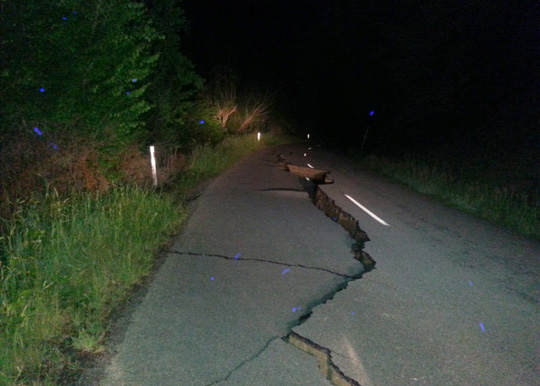Christchurch, New Zealand, Nov 14: At least two people were killed and more fatalities were feared after a powerful 7.8 earthquake struck New Zealand today, while residents in coastal areas fled following tsunami warnings.

As dawn broke there was scant information from many rural villages in the South Island, which were isolated by landslips and fractured telephone communications as strong aftershocks continued for several hours.
Prime Minister John Key confirmed two people had died and said "we cannot rule out" that number will rise, nearly seven hours after the main quake.
Police were trying to reach the scene of one fatality at a remote property 150 kilometres north of Christchurch while another person died in a historic homestead which collapsed at the nearby fishing village of Kaikoura.
"At this point we are unable to give precise details of what caused those fatalities," Key said, adding that communication problems made it difficult to get information.
Helicopters were taking officials workers to the worst-affected area, he said.
"As soon as we can get a much better assessment of the actual damage then we can work out the next steps."
Soon after the earthquake, tsunami warning sirens were activated in South Island coastal towns and along the east coast of the North Island, with police and emergency workers going door to door to evacuate seaside properties.
The ministry of civil defence, responsible for emergency management in New Zealand, initially warned of a "destructive tsunami" with waves of up to five metres (16 feet).
The first waves were measured around two metres and four hours later authorities downgraded the warning, but said risks remained.
The earthquake struck at 12:02 AM Monday (16:32 IST Sunday) and was 23 kilometres deep, the US Geological Survey said, putting the epicentre near the alpine tourist village of Hanmer and the rural township of Cheviot in North Canterbury, South Island.
It was one of the most powerful shakes to rock earthquake-prone New Zealand and ignited painful memories for residents in Christchurch which was devastated five years ago by a 6.3 tremor which killed 185 people.
"It was massive and really long," Tamsin Edensor, a mother of two in Christchurch, told AFP, describing the powerful quake as the biggest since the 2011 tremor which was one of New Zealand's deadliest disasters.
"We were asleep and woken to the house shaking, it kept going and going and felt like it was going to build up."
The main tremor was followed by a series of strong aftershocks and there were reports of damaged houses. Roads were cut and rail and ferry services were halted.
People took to social media to report damage with goods tipped from shelves and shattered glass littering streets. "Family friends in Cheviot say some houses are gone," one person tweeted.
Marie Black, a local councillor who lives about 50 kilometres north of Christchurch, told the New Zealand Herald there were reports of damage to buildings in the North Canterbury region.
"It was a significant shake, I have felt several aftershocks and it is very unnerving," she said.
In the capital city Wellington, where shattered glass littered inner city streets, rail and bus services were cancelled and people were advised not to try to go to work today.
In several cities guests were forced to evacuate hotels when the quake hit, including Nelson, about 200 kilometres from the quake centre where the touring Pakistan cricket team are staying.
"Some of the boys were in prayer, some were watching the India-England Test on TV when we felt the windows shake," team manager Wasim Bari told ESPNcricinfo.
In September, a strong 7.1-magnitude earthquake struck the east coast of New Zealand, generating a small tsunami, but no significant damage or injuries were reported.
New Zealand is on the boundary of the Australian and Pacific tectonic plates, which form part of the so-called "Ring of Fire", and experiences up to 15,000 tremors a year.






Comments
Add new comment